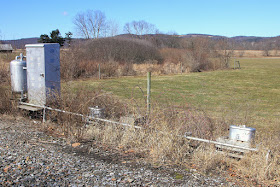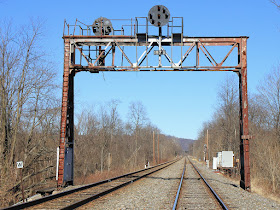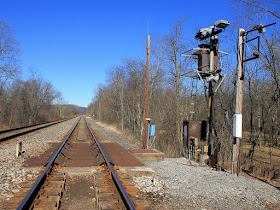As NS re-signaling efforts continue to wipe away large amounts of PRR heritage, I embarked on a mission to document the signaling on the NS Buffalo Line between Harrisburg and Lock Haven. Part one of this mission, between Harrisburg and Northumberland, was completed in the summer of 2017. Part 2 would cover the remaining signals between Williamsport and Lock Haven, specifically the Linden wye, CP-PINE, the two-track signal bridges and whatever was left over at CP-LANE and Lock Haven. Along the way I was also able to catch some power from NS and various local short lines.
You can view the entire set of photos here.
We begin back at Sunbury where in the previous trip we had neglected to visit an old Reading railroad signal bridge that once governed eastbound traffic at SF interlocking. Today the gantry spans a parking lot.
Adjacent to the signal bridge is the former Reading Railroad passenger station, which is now a law office.
In the former PRR Northumberland Yard NS SD60I #6754 and SD40-2 #613 were waiting to take out the next manifest freight to Harrisburg or Allentown.
The North Shore railroad runs on the north shore of the Susquehanna River's eastern branch and rents yard space in the former PRR Northumberland complex. Here we can see North Shore SW1500's #1942 and #2238.
The Linden Wye on the Buffalo Line west of Williamsport is bounded by CP-SOUTH LINDEN, CP-LINDEN and CP-RIVER. Here we see CP-SOUTH LINDEN with a new mast signal already in place. An earlier layout is evidenced by the long distance between the northbound home signal and the switch is protects. The re-signaling effort will contract the interlocking limits.
There is also evidence of both the old layout and the the use of pneumatic point machines by this rusting US&S A-5 unit and the out of service air line.
Originally serving two tracks, today the PRR signal bridge at CP-LINDEN supports a single signal.
There is another disused air plant, which was taken out of service sometime after 2006.
The Buffalo Line was an early CTC experiment for the PRR, which purchased custom relay huts, each with a keystone above the entry. Here the hut for CP-LINDEN is seen next to its replacements.
The Buffalo Line CTC project is also know for it's use of PRR pedestal signals with red lenses on the upper head diverging route signals.
CP-RIVER is located just north of the Susquehanna River bridge that connects to the various industrial tracks that serve Williamsport Proper. Although the Main Line, Rockville to Buffalo, runs through South Williamsport, the PRR had a line directly serving the city and also connecting to the Elmira Branch.
The signal used to be located at the far end of the bridge, but NS has already taken the trouble to relocate it and shrink the interlocking limits.
Another feature of the Linden Wye are automatic PRR dwarf exit signals on the tight eastern leg. Without a route lined at the next interlocking they default to Slow Approach. These are also to be eliminated.
The next accessible interlocking was CP-PINE, which marks the start of a double track segment that runs all the way to Lock Haven. Here we see some NS equipment involved with the re-signaling process.
Moving the northbound signal mast to the other side of track will eliminate potential property line conflicts with this homeowner.
This Milepost 199 signal bridge in McElhattan, PA has been a railfan photo backdrop for decades and is an uncommon two-track version of the PRR type.
Two miles up the line the Milepost 197 signal bridge only governs the main track as the siding was used by Conrail as a scale track.
The Weigh-In-Motion scale was installed by Conrail when coal from central PA was a major business. in addition to the actual scane itself, the scale setup also has video recording capability as well as a high load detector.
For some inexplicable reason the electronic equipment was placed in huts on a platform over an adjacent creek. The huts have been heavily armoured against theft and vandalism.
Zoom view of the MP 197 complex.
Unfortunately CP-LANE had already been re-signaled.
However the original relay hut had been left in place with its Conrail era sign.
The old PRR station at Lock Haven is still active as an NS crew and radio base.
In the yard I happened to catch a very rare NS GP59(!) which uses a 12-cylinder EMD 710 engine to generate 3000hp.
At CP-LOCK HAVEN we see the old PRR relay hut, raised against flooding, as well as the new southbound NS color light signal. To the right the Nitney and Bald Eagle line diverges to head down to join the PRR Main Line at Tyrone. The "End 171" sign gives away NS's shocking decision to outright scrap the entire CTC setup between here and Driftwood, PA, where NS operations end in favor of a number of regional carriers that not lease it. As one can see from the northbound cantilever, NS had been to just re-signal the existing CTC setup, but obviously somone did the math and decided to just scrap the signaling all together.
The old signaling equipment was being collected behind the Lock Haven station.
The cabinets still had all the old shelf relays inside including US&S style DN neutral relays and style CD code following relays.
Typically used for cab signaling, mains frequency pulse codes were often used for in-rail block state transmission to eliminate the need for pole line transmission. This style DM code generator creates a 120 pulse per minute code, typically used to represent the Approach Medium indication.
The Lycoming Valley Railroad is based at the old PRR Williamsport Yard and serves the industries on the north side of the Susquehanna River. Here we see LVRR SW9's #231 and #239 along with GP35R #2011.
The North Shore and Lycoming Valley Railroad are both owned by the same local economic development organization and here NSHR GP38-2 #2017 is waiting outside the LVRR shoppes for service. Apparently the North Shore was Railway Age's 2017 short line of the year.
I'll finish up with a shot of LVRR GP35R's #2011 and #2016.
That's it for this set. Next week tune in as I visit Amtrak's NEC at Perryman, MD.
Copy.txt
Displaying Copy.txt.



































No comments:
Post a Comment